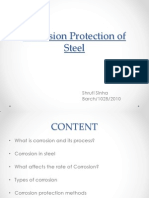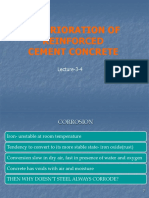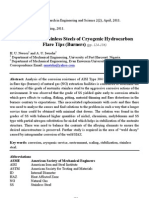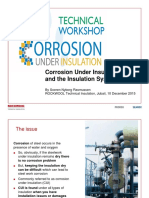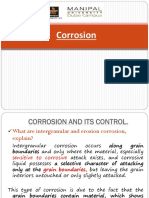Galvanic Corrosion Protect
Galvanic Corrosion Protect
Uploaded by
Jagadeesh Chandra BoseCopyright:
Available Formats
Galvanic Corrosion Protect
Galvanic Corrosion Protect
Uploaded by
Jagadeesh Chandra BoseOriginal Title
Copyright
Available Formats
Share this document
Did you find this document useful?
Is this content inappropriate?
Copyright:
Available Formats
Galvanic Corrosion Protect
Galvanic Corrosion Protect
Uploaded by
Jagadeesh Chandra BoseCopyright:
Available Formats
www.clearcoproducts.
com
215 639-2640
Galvanic Corrosion
Understanding galvanic corrosion can help reduce the risks of corrosion on steel structures.
By D.J. Bartlett, CTI Consultants Pty Ltd
Few designers of steel structures would claim ignorance of galvanic corrosion. Yet, based on the bitter experience of
field service, it remains a common and poorly understood phenomenon that can greatly reduce the service life of a
structure.
Galvanic corrosion, often termed bimetallic or dissimilar metal corrosion, is the phenomenon whereby direct
contact between two metals can accelerate the corrosion of one of them. Painted steel structures in particular can be
vulnerable to such corrosion in moist and immersed service.
Galvanic corrosion occurs because of an electro potential difference between the metals in contact. The
electro potential difference causes a current to flow between the metals when covered by an electrolyte (a chemical
solution in water). This electrolyte may be quite dilute; in fact, potable water usually contains enough dissolved salts to
cause a problem under the right conditions. Thus, one metal (the cathode) is protected at the expense of the other (the
anode), which corrodes at an accelerated rate.
Causes of Galvanic Corrosion
The four causes discussed below are also important in determining the rate of galvanic corrosion.
Electro potential
When placed in the same electrolyte, different metals have a different electro potential. This means that when two
metals are electrically coupled in the same solution, current will flow between them, causing corrosion of the more
active metal at a rate proportional to the current. Thus, the more inert or passive metal, termed the cathode, will result
in corrosion of the more corrodible or active metal, termed the anode.
The greater the potential difference between the metals, the greater the tendency for corrosion. Metals can be
convientely arranged according to increasing degrees of reactivity, as shown in the electrochemical series.
The Environment
The nature of the environment has a crucial influence on the rate of galvanic corrosion; in a dry area such as within
buildings or on a well-drained structure such as a roof, galvanic couples can be used successfully, while the same
combination in sea or fresh water immersion might be catastrophic.
For example stainless steel strapping on galvanized fixings in seawater immersion would cause serious local
corrosion of the galvanizing. In contrast, in a benign atmospheric environment, stainless steel not only has a negligible
impact on the life of the galvanizing but also can be used to advantage. Had the strapping on the bus stop sign been
made from galvanized steel, even of the same zinc thickness, the service life would be considerable.
Proximity of Anode and Cathode
The most severe galvanic corrosion occurs closest to the anode/cathode junction. Because galvanic corrosion is an
electrochemical process, the length of the resistance path through the electrolyte governs current flow. Thus, the further
the current has to travel, the greater the resistance path, resulting in less corrosion to the junction.
Corrosion will be more widespread where the electrical conductivity of the electrolyte is higher. It can expect
that corrosion will be more localized for identical anode/cathode junctions, on the junction immersed in fresh water
than on the one immersed in seawater. Seawater has much higher conductivity than fresh water. Corrosion will also be
more localized on wet, rather than fully immersed surfaces.
Cathode to Anode Ratio
The ratio of the area of the cathodic metal to the anodic metal is a critical factor in galvanic corrosion. For
example, the sump on a cooling tower in South Australia, lined with a coal tar epoxy showed pitting
corrosion in less than 18 months. Large, uncoated copper pipes (cathode), immersed and in direct electrical
contact with the steel (anode), caused the accelerated corrosion: Ironically, had no protective coating been
applied to the steel, corrosion would have been more general. Perforation of the steel would have been
delayed, because the corrosion would have been widespread, not localized. This phenomenon would have
resulted because the copper pipes were unpainted and the steel coated. The anode was the steel at the small,
inevitable pinholes in the coating. (Hence, the anodes were very small compared with the cathodic copper.)
Had the steel been uncoated, the anode would have been very large and the attack more even (as in the
example below).
Solutions
There are a number of ways to reduce or eliminate galvanic corrosion; however, the most appropriate
depend on the problem. Some suggested solutions appear below.
Selection of Metals
Metals close together in the electrochemical series will have little difference in electro potential, and, therefore, little
effect on each other. For example, mild steel and cast iron are the most common construction materials and can be
successfully used together. However, in wet environments, the attachment of small areas of other metals can be a
problem. The use of small, more active metal fixings (e.g., zinc, magnesium, and their alloys), can result in rapid
corrosion of these components. In contrast, small fixings of stainless steel or copper alloys can be appropriate because
of these metals are (cathodically) protected by the large mass of mild steel or cast iron. This feature can be used to
advantage, especially on critical items (e.g., fasteners on metal roof and wall claddings, specialized fittings on boats,
transmission towers, and valve seats, etc., in water pumps).
Coat the Cathode
One of the ironies of coating the cathode, or passive metal, is that the material may have been originally selected
because of its inherent corrosion resistance. It is the large, bare area of the cathode that presents the problem; reduction
of this area can minimize its corrosive influence. While insulating the cathode is ideal, it may not always be practicable.
Coating is often a viable operation; however, it is necessary to maintain the coating throughout its service life.
Cathodic Protection
Since it may not be possible to coat or insulate all items, cathodic protection may be an effective option. Cathodic
protection is based on the principles of galvanic corrosion. In this instance, the metal is protected using a more anodic
metal (such as zinc or magnesium) than the corroding material. The metals are electrically connected to the structure,
and immersed in the same electrolyte in close proximity to the metal causing the galvanic corrosion. Cathodic
protection was a supplementary procedure used to retard corrosion in the cooling tower and the water tank examples
described above. The technique is only practical in fully immersed or tidal situations.
Cathodic protection can also be implemented by applying external, direct current power (impressed current cathodic
protection) rather than using more corrodible “anodes” (sacrificial cathodic protection).
Modify the Environment
If the corrosivity of the environment is reduced, galvanic corrosion will be lessened as well. Corrosion can be reduced
if the junction of the two different metals can be made in a less corrosive location (e.g., atmospheric rather than
immersion service). In the case of immersed metals, coating the junction and treating the water with corrosion-
inhibiting chemicals are other supplementary procedures.
A related problem common in the building industry is the washing of water over copper and copper alloys. The
corrosive products deposit on more anodic metals, notably aluminum or galvanized steel. A particular example is the
use of copper-finned heat exchangers on galvanized roofs.
In tropical Australia, severe corrosion of the galvanized roofs occurred in about four years. In contrast, dry conditions
in central Australia have had little effect on similar roofs.
The solution given above are not mutually exclusive, and one or more approaches might be used on any given
structure.
The Benefits
Galvanic corrosion can be used to advantage in the cathodic protection of structures. The use of more cathodic metals is
crucial where any significant corrosion would be unacceptable. For example, the mating faces of valves or a fine wire
strainer in a water supply system is usually constructed of stainless steel or a copper alloy, with the remaining assembly
constructed of steel or cast iron. There will be some accelerated corrosion of the iron or mild steel immediately adjacent
to the cathodic metal. As long as the area is small relative to the area of the iron or steel, or the water is of low
conductivity, the galvanic effect can usually be accommodated.
Summary
The phenomenon of galvanic corrosion can be used to protect structures. Various metal fasteners and fixings attest to
the benefits of using corrosion-resistant metals in conjunction with more corrodible metals. However, many designers
presume that these corrosion-resistant metals (notably stainless steel, copper, and copper alloys) can be used without
discrimination with the same beneficial result. When large areas and amounts of these metals are, by design, in contact
with less corrosion-resistant metals, particularly in corrosive locals, the effect on the more anodic metals can be
catastrophic. Galvanic corrosion remains, therefore, widespread. It can only be avoided by designers and fabricators
who are aware of the important principles of, and procedures for, reducing or protecting against galvanic corrosion.
You might also like
- Corrosion Engineering Lecture 1Document12 pagesCorrosion Engineering Lecture 1ABNo ratings yet
- 34 - Caustic Embrittlement in The Bayer IndustryDocument8 pages34 - Caustic Embrittlement in The Bayer IndustryEmily FreireNo ratings yet
- Coating and Services: Interplan Asset IntegrityDocument22 pagesCoating and Services: Interplan Asset IntegritynarmathaNo ratings yet
- Icorr Certification Scheme: Icorr Training Courses (Itc)Document5 pagesIcorr Certification Scheme: Icorr Training Courses (Itc)sheikbbaNo ratings yet
- Formulation of A Biodegradable and Biosynthetic Latex PaintDocument166 pagesFormulation of A Biodegradable and Biosynthetic Latex PaintRose AdelineNo ratings yet
- WPC-21-0851 Field Scale Polymer Flooding of Heavy Oil The Pelican Lake Story - Heavy Oil - GoodDocument29 pagesWPC-21-0851 Field Scale Polymer Flooding of Heavy Oil The Pelican Lake Story - Heavy Oil - GoodGilbert OmittaNo ratings yet
- Failure Modes of RBIDocument5 pagesFailure Modes of RBIMuhammad OmarNo ratings yet
- Galvanic Corrosion: Printable VersionDocument49 pagesGalvanic Corrosion: Printable Versionhariom6353No ratings yet
- CorrosionDocument16 pagesCorrosionالGINIRAL FREE FIRENo ratings yet
- 2 Corrosion Its ControlDocument71 pages2 Corrosion Its ControlOjas BendaleNo ratings yet
- 7 Forms of Corrosion IDocument39 pages7 Forms of Corrosion IJesus De la RosaNo ratings yet
- Corrosion Protection of SteelDocument21 pagesCorrosion Protection of SteelShruti SinhaNo ratings yet
- Corrosion 2 PDFDocument46 pagesCorrosion 2 PDFEenadu paperNo ratings yet
- Deterioration of Reinforced Cement Concrete: Lecture-3-4Document26 pagesDeterioration of Reinforced Cement Concrete: Lecture-3-4Pratyush MishraNo ratings yet
- Corrosion 1Document9 pagesCorrosion 1Anonymous FRwkna2rNo ratings yet
- Lecture 4 - Corrosion and Types of CorrosionDocument121 pagesLecture 4 - Corrosion and Types of Corrosionlungeloz393No ratings yet
- Why Study Corrosion ?Document6 pagesWhy Study Corrosion ?Kimai BrackenNo ratings yet
- Corrosion: 2/engr Leonardo C Cuerdo, MSCDocument43 pagesCorrosion: 2/engr Leonardo C Cuerdo, MSCJayvee MauricioNo ratings yet
- Corrosion Assessment in Reinforced Concrete StructuresDocument32 pagesCorrosion Assessment in Reinforced Concrete Structuresdineshkumar rNo ratings yet
- Introduction To Surface EngineeringDocument26 pagesIntroduction To Surface Engineeringdu.maximeNo ratings yet
- Corrosion and Environmental Degradation of MaterialDocument9 pagesCorrosion and Environmental Degradation of MaterialAbie RexoMenNo ratings yet
- Corrosion Monitoring PDFDocument24 pagesCorrosion Monitoring PDFMohamedGhanemNo ratings yet
- Slide 2 Types CorrosionDocument18 pagesSlide 2 Types CorrosionArief SambestNo ratings yet
- Corrosive Damage in Metals and Its PreventionDocument36 pagesCorrosive Damage in Metals and Its Preventionsamurai7_7783% (6)
- Corrosion: IntroducingDocument29 pagesCorrosion: Introducingkeval patelNo ratings yet
- CorrosionDocument65 pagesCorrosionSurendra Kamal100% (9)
- Atmospheric Corrosion MechanismDocument27 pagesAtmospheric Corrosion MechanismmghgolNo ratings yet
- Corrosion of Stainless Steels of Cryogenic Hydrocarbon Flare Tips BurnersDocument13 pagesCorrosion of Stainless Steels of Cryogenic Hydrocarbon Flare Tips Burnersravikanth_rNo ratings yet
- Forms of Corrosion: CHE-545-172 DR Ime B.ObotDocument17 pagesForms of Corrosion: CHE-545-172 DR Ime B.ObotAnonymous NxpnI6jCNo ratings yet
- Corrosion Prevention 316Document49 pagesCorrosion Prevention 316Zohaib RasheedNo ratings yet
- Corrosion in Fertilizer Industries PDFDocument145 pagesCorrosion in Fertilizer Industries PDFTaghreed ZewailNo ratings yet
- Mechanism of Boiler and Steam Condensate CorrosionDocument3 pagesMechanism of Boiler and Steam Condensate CorrosionMutasim Hasan MehranNo ratings yet
- EN380 Naval Materials Science and Engineering Course Notes, U.S. Naval AcademyDocument13 pagesEN380 Naval Materials Science and Engineering Course Notes, U.S. Naval AcademyMad Max100% (1)
- Corrosion PDFDocument51 pagesCorrosion PDFSuryansh Singh100% (1)
- EECE 574 - Adaptive ControlDocument73 pagesEECE 574 - Adaptive Controllamis rezkiNo ratings yet
- Corrosion Inhibition Approach of Oil Production Systems in Offshore OilfieldsDocument5 pagesCorrosion Inhibition Approach of Oil Production Systems in Offshore OilfieldsKArenNo ratings yet
- Corrosion: by Mrs - Rajeshree PanigrahiDocument80 pagesCorrosion: by Mrs - Rajeshree PanigrahiRajeshree PanigrahiNo ratings yet
- ROOKWOOL (Non Contact Insulation)Document28 pagesROOKWOOL (Non Contact Insulation)devangmajithiaNo ratings yet
- Corrosion of Materials and Its Prevention: Dr. Abdul ShakoorDocument40 pagesCorrosion of Materials and Its Prevention: Dr. Abdul ShakoorAbdulNo ratings yet
- CorrosionDocument19 pagesCorrosiongopal singhNo ratings yet
- Type of CorrosionDocument12 pagesType of CorrosionNur Afiqah100% (2)
- Intergranular CorrosionDocument23 pagesIntergranular CorrosionAdelNo ratings yet
- Corrosion Management Issue140 LowResDocument32 pagesCorrosion Management Issue140 LowResReno100% (1)
- Types of CorrosionDocument1 pageTypes of CorrosionprathapNo ratings yet
- Biological Induced CorrosionDocument22 pagesBiological Induced CorrosionHemanth100% (1)
- Paul Vinik State Structural Material Systems EngineerDocument7 pagesPaul Vinik State Structural Material Systems EngineerJoe BlagNo ratings yet
- Corrosion PresentationDocument22 pagesCorrosion PresentationIshu Attri100% (1)
- Galvanic CorrosionDocument8 pagesGalvanic Corrosionravi8373No ratings yet
- CorrosionDocument81 pagesCorrosionsureshs83No ratings yet
- Chloride ErosionDocument31 pagesChloride ErosionCepi Sindang Kamulan100% (1)
- Corrosion Control Unit2-FinalDocument107 pagesCorrosion Control Unit2-FinalAshish MangalNo ratings yet
- CorrosionDocument8 pagesCorrosionGM VillaneaNo ratings yet
- Corrosionengg 151021181918 Lva1 App6891Document133 pagesCorrosionengg 151021181918 Lva1 App6891pm2013100% (1)
- An Overview of Austenitic and Ferritic Stainless Steels - The FabricatorDocument7 pagesAn Overview of Austenitic and Ferritic Stainless Steels - The FabricatorAhmadiBinAhmadNo ratings yet
- Engineering Failure Analysis: C.M.B. Martins, J.L. Moreira, J.I. MartinsDocument7 pagesEngineering Failure Analysis: C.M.B. Martins, J.L. Moreira, J.I. Martinspaneisan100% (1)
- CorrosionDocument79 pagesCorrosionaakash sharma100% (1)
- Corrosion - Erossion: Ulhas ThakurDocument14 pagesCorrosion - Erossion: Ulhas ThakurmkkamarajNo ratings yet
- Selective LeachingDocument13 pagesSelective LeachingMuhammad MohtashimNo ratings yet
- Corrosion Prevention For MetalsDocument17 pagesCorrosion Prevention For Metalsabdul100% (1)
- Corrosion ProcessDocument42 pagesCorrosion Processmujeebmehar100% (2)
- Galvanic Corrosion WikipediaDocument7 pagesGalvanic Corrosion WikipediaCharles HernandezNo ratings yet
- Galvanic Corrosion - Fact Sheet #10Document3 pagesGalvanic Corrosion - Fact Sheet #10onayasNo ratings yet
- Cobalt Precipitation With MgO - Material Balance From Kinetic SamplesDocument13 pagesCobalt Precipitation With MgO - Material Balance From Kinetic Samplesjoseph kafumbilaNo ratings yet
- Imine ReductionDocument4 pagesImine ReductionRatna Siti KhodijahNo ratings yet
- Weld Defects CswipDocument10 pagesWeld Defects CswipOLiver RobertNo ratings yet
- Bathing Soap ProductionDocument3 pagesBathing Soap ProductionFreedom AdishiNo ratings yet
- Alkenes and Alkynes Worksheet PDFDocument3 pagesAlkenes and Alkynes Worksheet PDFDoha Hosam Shalaby HamamNo ratings yet
- Nanofiltration and Reverse Osmosis Applied To Gold Mining Effluent Treatment and ReuseDocument15 pagesNanofiltration and Reverse Osmosis Applied To Gold Mining Effluent Treatment and Reusecuberbill1980No ratings yet
- Bromine Addition To Trans-Cinnamic AcidDocument4 pagesBromine Addition To Trans-Cinnamic AcidRaphael MendozaNo ratings yet
- En Additin RC 93210Document2 pagesEn Additin RC 93210Dinesh babuNo ratings yet
- Lab - Manual Bt-101 (Chemistry)Document39 pagesLab - Manual Bt-101 (Chemistry)Krishna MahajanNo ratings yet
- Sandvik 3re60 Tube and Pipe, Seamless: DatasheetDocument10 pagesSandvik 3re60 Tube and Pipe, Seamless: DatasheetVinay TrivediNo ratings yet
- Basics Fundamentals of Liquid Chromatography HPLCDocument35 pagesBasics Fundamentals of Liquid Chromatography HPLCDr-Abdulsamie Hassan Alta'eeNo ratings yet
- Chemical EORDocument50 pagesChemical EORAmmar Abdul HussainNo ratings yet
- 1.6 Inorganic IonsDocument11 pages1.6 Inorganic IonsericychenNo ratings yet
- Jee Most Important Questions Gadar SeriesDocument335 pagesJee Most Important Questions Gadar Seriesharshdhull2006No ratings yet
- Glo Concrete ViscoflowDocument3 pagesGlo Concrete ViscoflowarkarNo ratings yet
- Salt Spray TestDocument5 pagesSalt Spray Testsmith willNo ratings yet
- Automotive Catalytic ConvertersDocument2 pagesAutomotive Catalytic ConvertersShriyash DeshpandeNo ratings yet
- TPE Vs EPDM Vs SBR and QualityDocument10 pagesTPE Vs EPDM Vs SBR and QualityManas Mondal100% (1)
- Using The Sol-Gel ProcessDocument9 pagesUsing The Sol-Gel ProcessrathiluxNo ratings yet
- Ion ChromatographyDocument2 pagesIon ChromatographyalexpharmNo ratings yet
- Chem 6Document24 pagesChem 6Adi SoNo ratings yet
- Absorption of Mineral Nutrients by RootsDocument24 pagesAbsorption of Mineral Nutrients by Rootskovachjk100% (2)
- Acid Rain - Acid DepositionDocument4 pagesAcid Rain - Acid DepositionjincodyNo ratings yet
- 366153-learner-guide-for-cambridge-igcse-9-1-chemistry-0971Document49 pages366153-learner-guide-for-cambridge-igcse-9-1-chemistry-0971Aleeza FatimaNo ratings yet
- Ficha Tecnica Anillos Oval RingDocument8 pagesFicha Tecnica Anillos Oval RingAndres AlfonsoNo ratings yet
- Electrode Selector GuideDocument2 pagesElectrode Selector Guidetanase.gabriel1993No ratings yet
- Green Diesel Technology by Eni/UOPDocument13 pagesGreen Diesel Technology by Eni/UOPjonathanNo ratings yet
- Disinfection & Sterilization: DR: Dina RamadanDocument26 pagesDisinfection & Sterilization: DR: Dina RamadanSudheer RevanthNo ratings yet











